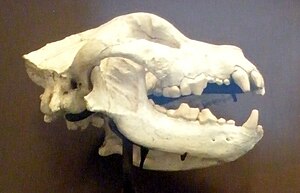Borophagus
| Borophagus | ||||||||||||
|---|---|---|---|---|---|---|---|---|---|---|---|---|

Skull of Borophagus |
||||||||||||
| Temporal occurrence | ||||||||||||
| Middle Miocene to Pliocene | ||||||||||||
| approx. 12 to approx. 2 million years | ||||||||||||
| Locations | ||||||||||||
|
Florida, Mexico, Texas |
||||||||||||
| Systematics | ||||||||||||
|
||||||||||||
| Scientific name | ||||||||||||
| Borophagus | ||||||||||||
| Cope , 1892 | ||||||||||||
Borophagus (Greek: boros - voracious, phago - to eat) is an extinct genus from the family of dogs (Canidae). It is eponymous for the subfamily Borophaginae and was limited to North America throughout its life.
Borophagus reached a body weight of about 20–40 kg and resembled a hyena . However, the sloping back line typical of today's hyenas was missing. The genus represents the last member of the Borophaginae, a special subfamily of dogs. Borophagus probably developed from Epicyon and appeared for the first time in the Middle Miocene about 12 million years ago in the west of the North American continent. The 4th lower premolars were even more developed than with Epicyon , which led to an extreme bite. Both genera, like today's large hyenas, may have been adapted to breaking large bones. As a further adaptation to this niche, the lower jaw of these forms was extremely strong and the forehead was strongly arched. Borophagus had been widespread across the continent at the latest since the Upper Miocene, around 9 million years ago . The last species in the genus was Borophagus diversidens . This reached a shoulder height of about 60 cm. It was not until the beginning of the Pleistocene , about 2 million years ago, that the large dog disappeared and with it the subfamily of the Borophaginae. The last representatives of the genus had to compete with the slender hyena Chasmaporthetes , which immigrated from Eurasia to North America in the Pliocene. The niche of the large dogs was occupied by species of the genus Canis during the Pleistocene . The representatives of the genus Canis were all relatively small at the time of Borophagus , until Canis armbrusteri , a wolf-sized form of the genus first appeared in the fossil record of North America around 1.5 million years ago. From this species the huge Canis dirus developed in the middle Pleistocene , which was the largest type of dog in the late Pleistocene.
The following types are known:
- Borophagus littoralis (late Miocene)
- Borophagus pugnator (late Miocene)
- Borophagus orc (late Miocene)
- Borophagus parvus (late Miocene)
- Borophagus secundus (late Miocene)
- Borophagus hilli (late Miocene)
- Borophagus dudleyi (late Miocene)
- Borophagus diversidens (Pliocene)
literature
- Xiaoming Wang, Richard H. Tedford, Mauricio Antón: Dogs, their fossil relatives & evolutionary history. Columbia University Press, New York 2008. ISBN 978-0-231-13528-3
Individual evidence
- ↑ Wang et al., 2008 (p. 46 and p. 49)
- ↑ Wang et al., 2008 (p. 149)
- ↑ Wang et al., 2008 (p. 60)
- ↑ Wang et al., 2008 (p. 172)
